boot FIAT DOBLO COMBI 2012 Owner handbook (in English)
[x] Cancel search | Manufacturer: FIAT, Model Year: 2012, Model line: DOBLO COMBI, Model: FIAT DOBLO COMBI 2012Pages: 283, PDF Size: 6.31 MB
Page 193 of 283
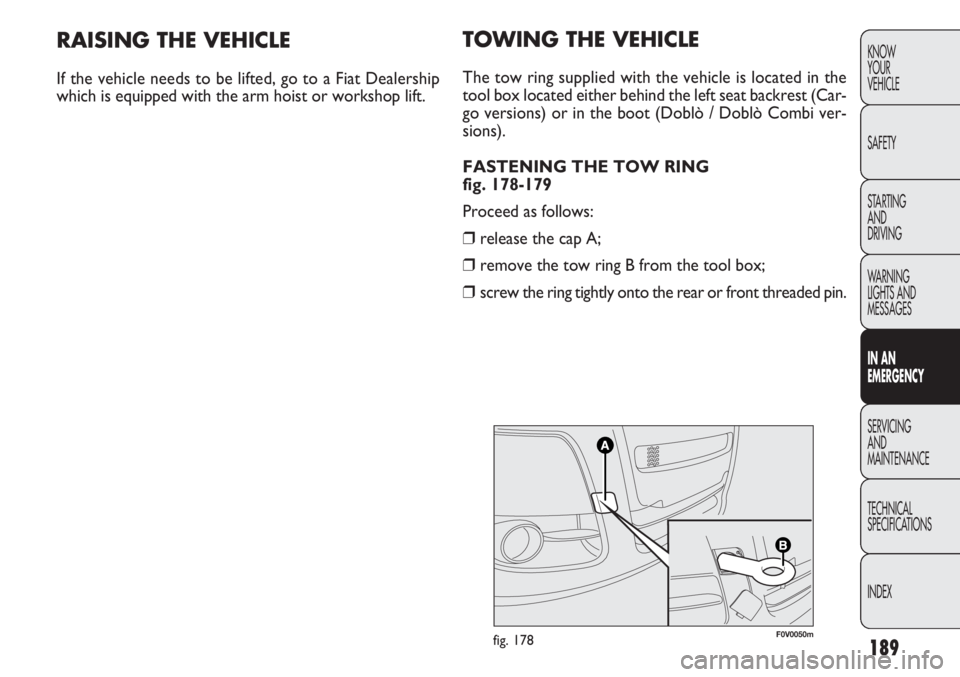
189
KNOW
YOUR
VEHICLE
SAFETY
STARTING
AND
DRIVING
WARNING
LIGHTS AND
MESSAGES
IN AN
EMERGENCY
SERVICING
AND
MAINTENANCE
TECHNICAL
SPECIFICATIONS
INDEXTOWING THE VEHICLE
The tow ring supplied with the vehicle is located in the
tool box located either behind the left seat backrest (Car-
go versions) or in the boot (Doblò / Doblò Combi ver-
sions).
FASTENING THE TOW RING
fig. 178-179
Proceed as follows:
❒ release the cap A;
❒ remove the tow ring B from the tool box;
❒ screw the ring tightly onto the rear or front threaded pin.
F0V0050mfig. 178
RAISING THE VEHICLE
If the vehicle needs to be lifted, go to a Fiat Dealership
which is equipped with the arm hoist or workshop lift.
Page 196 of 283
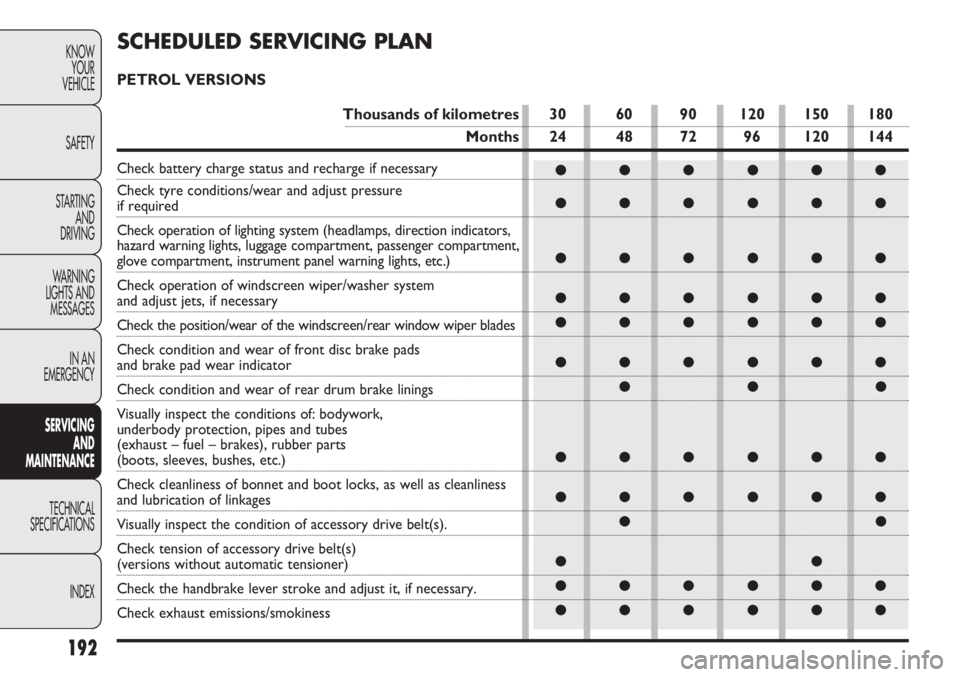
192
KNOWYOUR
VEHICLE
SAFETY
STARTING AND
DRIVING
WARNING
LIGHTS AND MESSAGES
IN AN
EMERGENCY
SERV IC
ING
AND
MAINTENANCE
TECHNICAL
SPECIFICA TIONS
INDEX
●●●●●●
●●●●●●
●●●●●●
●●●●●●
●●●●●●
●●●●●● ●●●
●●●●●●
●●●●●● ●●
●●
●●●●●●
●●●●●●
SCHEDULED SERVI CING PLAN
PETROL VERSIONS
Thousands of kilometres 30 60 90 120 150 180
Months 24 48 72 96 120 144
Check battery charge status and recharge if necessary
Check tyre conditions/wear and adjust pressure
if required
Check operation of lighting system (headlamps, direction indicators,
hazard warning lights, luggage compartment, passenger compartment,
glove compartment, instrument panel warning lights, etc.)
Check operation of windscreen wiper/washer system
and adjust jets, if necessary
Check the position/wear of the windscreen/rear window wiper blades
Check condition and wear of front disc brake pads
and brake pad wear indicator
Check condition and wear of rear drum brake linings
Visually inspect the conditions of: bodywork,
underbody protection, pipes and tubes
(exhaust – fuel – brakes), rubber parts
(boots, sleeves, bushes, etc.)
Check cleanliness of bonnet and boot locks, as well as cleanliness
and lubrication of linkages
Visually inspect the condition of accessory drive belt(s).
Check tension of accessory drive belt(s)
(versions without automatic tensioner)
Check the handbrake lever stroke and adjust it, if necessary.
Check exhaust emissions/smokiness
Page 198 of 283
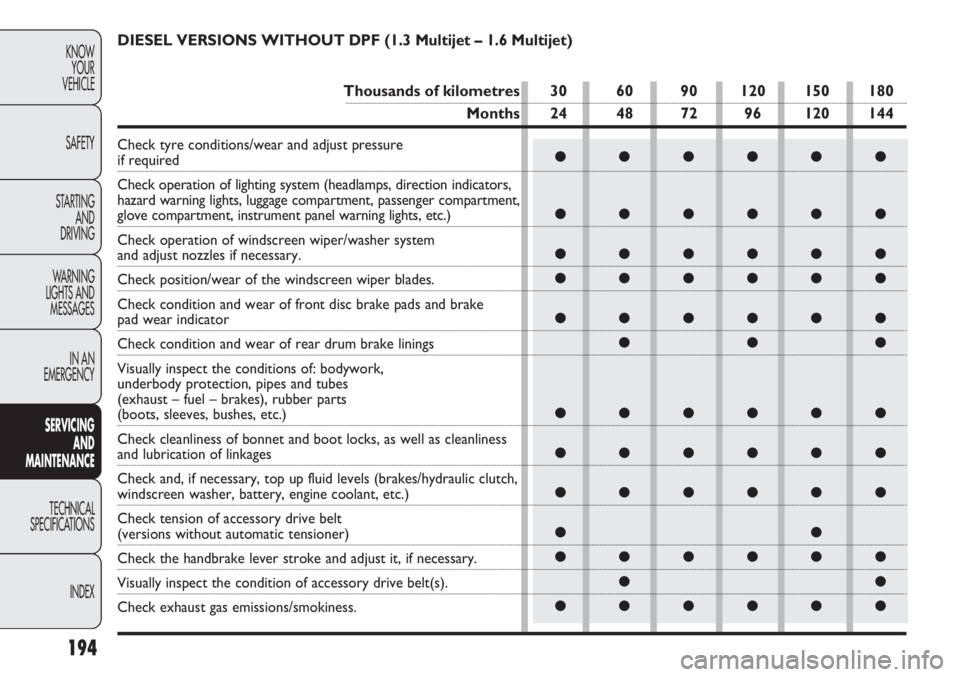
194
KNOWYOUR
VEHICLE
SAFETY
STARTING AND
DRIVING
WARNING
LIGHTS AND MESSAGES
IN AN
EMERGENCY
SERV IC
ING
AND
MAINTENANCE
TECHNICAL
SPECIFICA TIONS
INDEX
●●●●●●
●●●●●●
●●●●●●
●●●●●●
●●●●●● ●●●
●●●●●●
●●●●●●
●●●●●●
●●
●●●●●● ●●
●●●●●●
DIESEL VERSIONS WITHOUT DPF (1.3 Multijet – 1.6 Multijet)
Thousands of kilometres 30 60 90 120 150 180
Months 24 48 72 96 120 144
Check tyre conditions/wear and adjust pressure if required
Check operation of lighting system (headlamps, direction indicators,
hazard warning lights, luggage compartment, passenger compartment,
glove compartment, instrument panel warning lights, etc.)
Check operation of windscreen wiper/washer system
and adjust nozzles if necessary.
Check position/wear of the windscreen wiper blades.
Check condition and wear of front disc brake pads and brake
pad wear indicator
Check condition and wear of rear drum brake linings
Visually inspect the conditions of: bodywork,
underbody protection, pipes and tubes
(exhaust – fuel – brakes), rubber parts
(boots, sleeves, bushes, etc.)
Check cleanliness of bonnet and boot locks, as well as cleanliness
and lubrication of linkages
Check and, if necessary, top up fluid levels (brakes/hydraulic clutch, \
windscreen washer, battery, engine coolant, etc.)
Check tension of accessory drive belt
(versions without automatic tensioner)
Check the handbrake lever stroke and adjust it, if necessary.
Visually inspect the condition of accessory drive belt(s).
Check exhaust gas emissions/smokiness.
Page 200 of 283
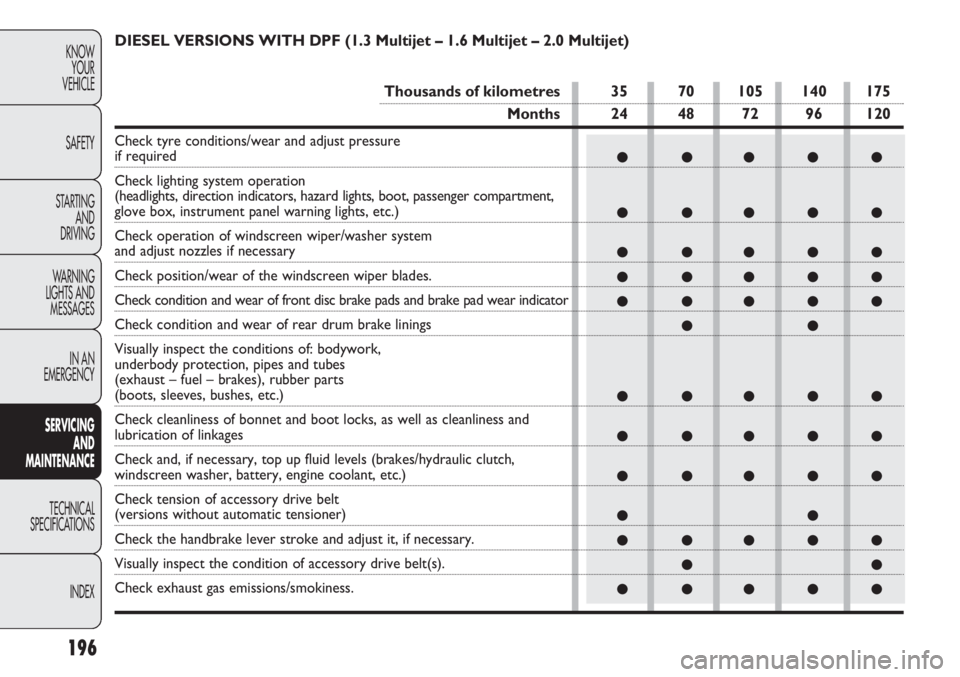
196
KNOWYOUR
VEHICLE
SAFETY
STARTING AND
DRIVING
WARNING
LIGHTS AND MESSAGES
IN AN
EMERGENCY
SERV IC
ING
AND
MAINTENANCE
TECHNICAL
SPECIFICA TIONS
INDEX
● ●●●●
● ●●●●
● ●●●●
● ●●●●
● ●●●● ●●
● ●●●●
● ●●●●
● ●●●●
●●
● ●●●● ●●
● ●●●●
DIESEL VERSIONS WITH DPF (1.3 Multijet – 1.6 Multijet – 2.0 Multijet)
Thousands of kilometres 35 70 105 140 175
Months 24 48 72 96 120
Check tyre conditions/wear and adjust pressure if required
Check lighting system operation
(headlights, direction indicators, hazard lights, boot, passenger compa\
rtment,
glove box, instrument panel warning lights, etc.)
Check operation of windscreen wiper/washer system
and adjust nozzles if necessary
Check position/wear of the windscreen wiper blades.
Check condition and wear of front disc brake pads and brake pad wear ind\
icator
Check condition and wear of rear drum brake linings
Visually inspect the conditions of: bodywork,
underbody protection, pipes and tubes
(exhaust – fuel – brakes), rubber parts
(boots, sleeves, bushes, etc.)
Check cleanliness of bonnet and boot locks, as well as cleanliness and
lubrication of linkages
Check and, if necessary, top up fluid levels (brakes/hydraulic clutch, \
windscreen washer, battery, engine coolant, etc.)
Check tension of accessory drive belt
(versions without automatic tensioner)
Check the handbrake lever stroke and adjust it, if necessary.
Visually inspect the condition of accessory drive belt(s).
Check exhaust gas emissions/smokiness.
Page 202 of 283
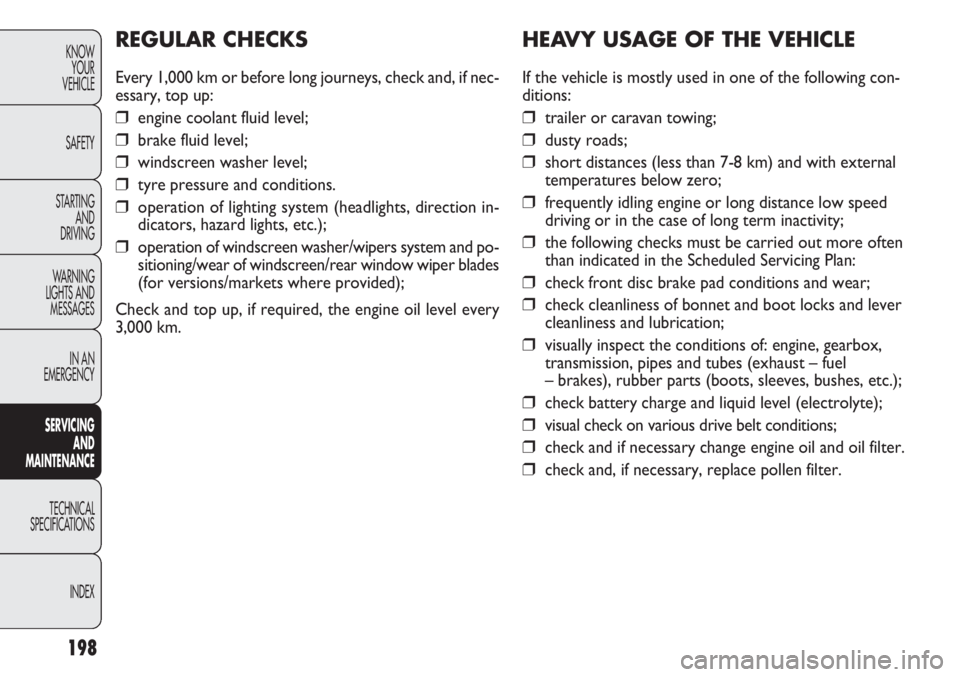
198
KNOWYOUR
VEHICLE
SAFETY
STARTING AND
DRIVING
WARNING
LIGHTS AND MESSAGES
IN AN
EMERGENCY
SERV IC
ING
AND
MAINTENANCE
TECHNICAL
SPECIFICA TIONS
INDEX
HEAV Y USAGE OF THE VEHICLE
If the vehicle is mostly used in one of the following con-
ditions:
❒trailer or caravan towing;
❒dusty roads;
❒short distances (less than 7-8 km) and with external
temperatures below zero;
❒frequently idling engine or long distance low speed
driving or in the case of long term inactivity;
❒the following checks must be carried out more often
than indicated in the Scheduled Servicing Plan:
❒check front disc brake pad conditions and wear;
❒check cleanliness of bonnet and boot locks and lever
cleanliness and lubrication;
❒visually inspect the conditions of: engine, gearbox,
transmission, pipes and tubes (exhaust – fuel
– brakes), rubber parts (boots, sleeves, bushes, etc.);
❒check battery charge and liquid level (electrolyte);
❒visual check on various drive belt conditions;
❒check and if necessary change engine oil and oil filter.
❒ check and, if necessary, replace pollen filter.
REGULAR CHECKS
Every 1,000 km or before long journeys, check and, if nec-
essary, top up:
❒ engine coolant fluid level;
❒ brake fluid level;
❒ windscreen washer level;
❒ tyre pressure and conditions.
❒ operation of lighting system (headlights, direction in-
dicators, hazard lights, etc.);
❒ operation of windscreen washer/wipers system and po-
sitioning/wear of windscreen/rear window wiper blades
(for versions/markets where provided);
Check and top up, if required, the engine oil level every
3,000 km.
Page 212 of 283
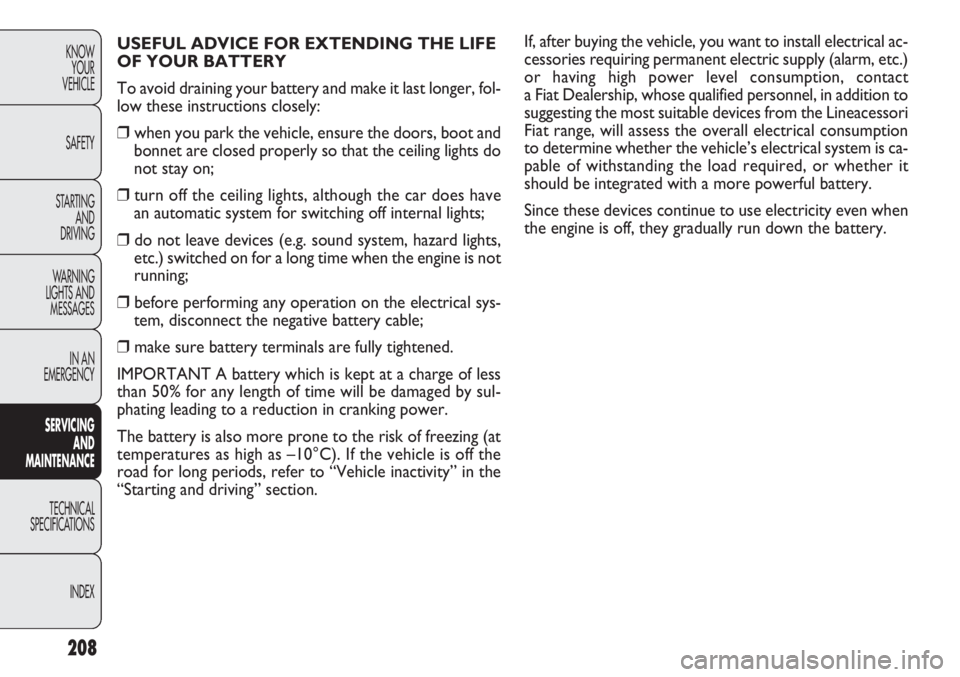
If, after buying the vehicle, you want to install electrical ac-
cessories requiring permanent electric supply (alarm, etc.)
or having high power level consumption, contact
a Fiat Dealership, whose qualified personnel, in addition to
suggesting the most suitable devices from the Lineacessori
Fiat range, will assess the overall electrical consumption
to determine whether the vehicle’s electrical system is ca-
pable of withstanding the load required, or whether it
should be integrated with a more powerful battery.
Since these devices continue to use electricity even when
the engine is off, they gradually run down the battery.
208
KNOWYOUR
VEHICLE
SAFETY
STARTING AND
DRIVING
WARNING
LIGHTS AND MESSAGES
IN AN
EMERGENCY
SERV IC
ING
AND
MAINTENANCE
TECHNICAL
SPECIFICA TIONS
INDEX
USEFUL ADVICE FOR EXTENDING THE LIFE
OF YOUR BATTERY
To avoid draining your battery and make it last longer, fol-
low these instructions closely:
❒ when you park the vehicle, ensure the doors, boot and
bonnet are closed properly so that the ceiling lights do
not stay on;
❒ turn off the ceiling lights, although the car does have
an automatic system for switching off internal lights;
❒ do not leave devices (e.g. sound system, hazard lights,
etc.) switched on for a long time when the engine is not
running;
❒ before performing any operation on the electrical sys-
tem, disconnect the negative battery cable;
❒ make sure battery terminals are fully tightened.
IMPORTANT A battery which is kept at a charge of less
than 50% for any length of time will be damaged by sul-
phating leading to a reduction in cranking power.
The battery is also more prone to the risk of freezing (at
temperatures as high as –10°C). If the vehicle is off the
road for long periods, refer to “Vehicle inactivity” in the
“Starting and driving” section.
Page 271 of 283
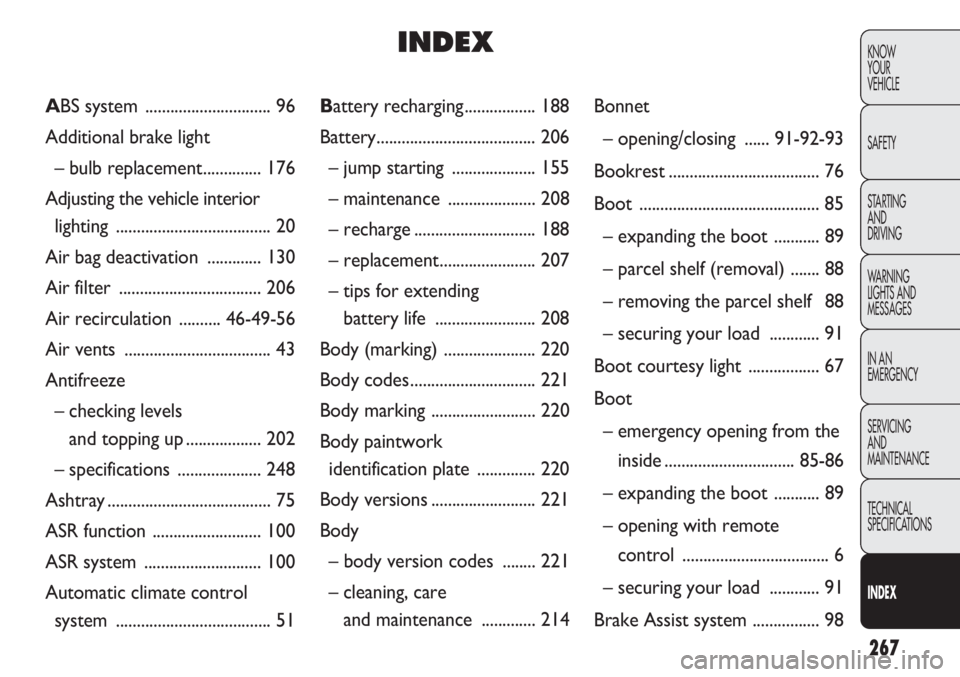
267
KNOW
YOUR
VEHICLE
SAFETY
STARTING
AND
DRIVING
WARNING
LIGHTS AND
MESSAGES
IN AN
EMERGENCY
SERVICING
AND
MAINTENANCE
TECHNICAL
SPECIFICATIONS
INDEX
Battery recharging ................. 188
Battery ...................................... 206
– jump starting .................... 155
– maintenance ..................... 208
– recharg e ............................. 188
– replace ment....................... 207
– tips for extending battery life ........................ 208
Body (mark ing) ...................... 220
Body codes .............................. 221
Body mark ing ......................... 220
Body paintwork identification plate .............. 220
Body vers ions ......................... 221
Body – body version codes ........ 221
– cleaning, care and maintenance ............. 214 Bonnet
– opening/closing ...... 91-92-93
Bookrest .................................... 76
Boot ........................................... 85
– expanding the boot ........... 89
– parcel shelf (removal) ....... 88
– removing the parcel shelf 88
– securing your load ............ 91
Boot courtesy light ................. 67
Boot – emergency opening from the inside ............................... 85-86
– expanding the boot ........... 89
– opening with remote contro l ................................... 6
– securing your load ............ 91
Brake Assist system ................ 98
A
BS system .............................. 96
Additional brake light – bulb replace ment.............. 176
Adjusting the vehicle interior lighting ..................................... 20
Air bag deactivation ............. 130
Air filter .................................. 206
Air recirculation ..........46-49-56
Air vents ................................... 43
Antifreeze – checking levels and topping up .................. 202
– specifications .................... 248
Ashtray ....................................... 75
ASR function .......................... 100
ASR system ............................ 100
Automatic climate control system ..................................... 51
INDEX
Page 275 of 283
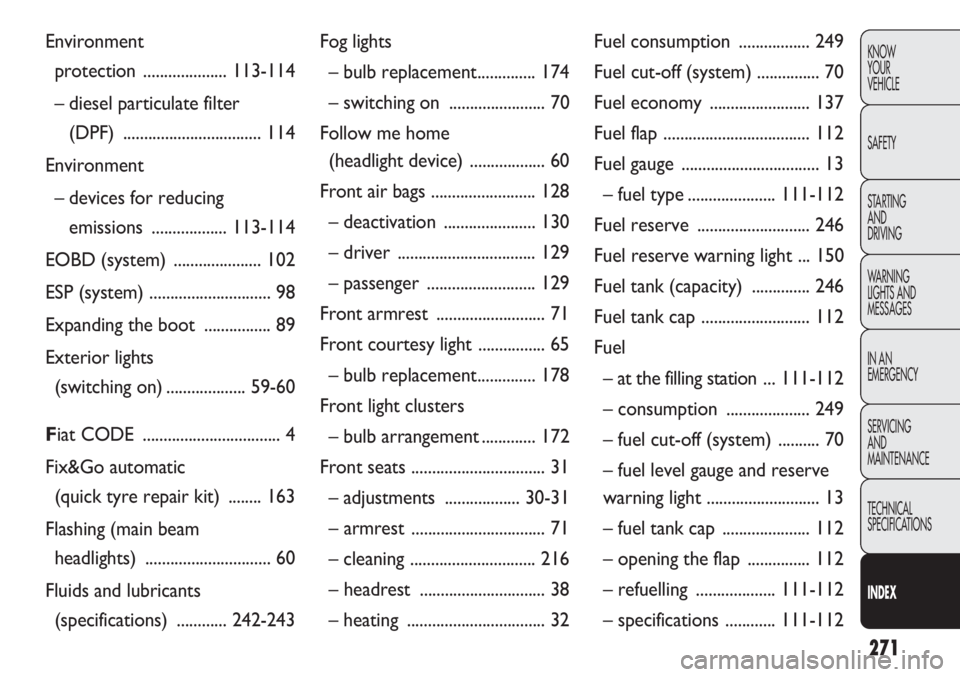
271
KNOW
YOUR
VEHICLE
SAFETY
STARTING
AND
DRIVING
WARNING
LIGHTS AND
MESSAGES
IN AN
EMERGENCY
SERVICING
AND
MAINTENANCE
TECHNICAL
SPECIFICATIONS
INDEXEnvironment protection .................... 113-114
– diesel particulate filter (DPF) ................................. 114
Environment – devices for reducing emissions ..................113-114
EOBD (system) ..................... 102
ESP (system) ............................. 98
Expanding the boot ................ 89
Exterior lights (switching on) ................... 59-60
F iat CODE ................................. 4
Fix&Go automatic (quick tyre repair kit) ........ 163
Flashing (main beam headlights) .............................. 60
Fluids and lubricants (specifications) ............242-243 Fog lights
– bulb replace ment.............. 174
– switching on ....................... 70
Follow me home (headlight device) .................. 60
Front air bags ......................... 128
– deactivation ...................... 130
– driver ................................. 129
– passenger .......................... 129
Front armrest .......................... 71
Front courtesy light ................ 65
– bulb replace ment.............. 178
Front light clusters – bulb arrangement ............. 172
Front seats ................................ 31
– adjustments .................. 30-31
– armrest ................................ 71
– cleaning .............................. 216
– headrest .............................. 38
– heating ................................. 32 Fuel consumption
................. 249
Fuel cut-off (s ystem) ............... 70
Fuel economy ........................ 137
Fuel fla p ................................... 112
Fuel gauge ................................. 13 – fuel type ..................... 111-112
Fuel reserve ........................... 246
Fuel reserve warning light ... 150
Fuel tank (capacity) .............. 246
Fuel tank cap .......................... 112
Fuel – at the filling station ... 111-112
– consumption .................... 249
– fuel cut-off (system) .......... 70
– fuel level gauge and reserve
warning light ........................... 13
– fuel tank cap ..................... 112
– opening the flap ............... 112
– refuelling ...................111-112
– specifications ............111-112